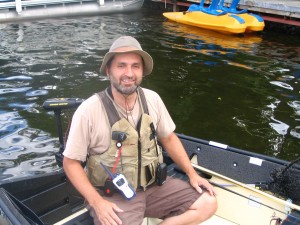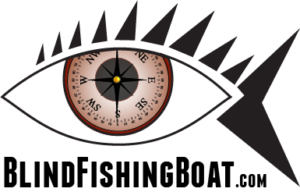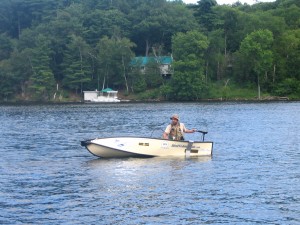Desert Lake Blind Fishing Porta-Bote Sea Trials
Trials of the Blind Fishing Porta-Bote over the 2008 season thus far have expanded on the results and recommendations reported on in 2007. A number of modifications are now in use and still more are in the process of being implemented.
Top Water Sonar:
I’m now only using one MiniGuide on the front of the boat as oppose to two and an automobile reverse sensor. I’m still connecting the MiniGuide to the bow cap using Velcro, and positioning the device about 6-8 inches in from the leading edge. The set-back has eliminated feedback from waves.
I’m running a 12-foot cable with 1/8 male headphone jacks at each end between the MiniGuide and a small rechargeable speaker that came with my Trekker. I’ve been clipping the speaker to one of the lanyard loops on my Salus PDF. I could Velcro the speaker to the bow plate as well, but I like to be able to turn the speaker off once I’ve come into range of a dock or other obstacle, which is something I would only be able to do by moving to the front of the boat, ; a feat that isn’t practical during docking.
I install and turn the MiniGuide and speaker on when underway, and turn off the units and disconnect the wire from the speaker when stationary.
Minn Kota Maxxum Trolling Motor:
To overcome the left-right zigzagging I use to experience when underway, I’ve modified the two stop collars on the shaft of the Minn Kota Maxxum electric trolling motor. By filing a female shaped “V” into the gap on the upper collar, and a similar shaped male “V” on the glide affixed to the lower collar, I now have an adjustable “straight ahead” tactile indicator that I can feel through the handle of the Minn Kota’s tiller. When the two V’s come together the motor’s position becomes fixed until such time that I move the tiller to make a course correction. I simply adjust the upper collar’s position with the thumb screw that loosens and tightens the collar until I have the boat travelling in a straight forward direction. I make sure that my load is distributed in the same manner after this point as shifts in the load from one side to another can cause the boat to go off course.
I’ve also begun using a Minn Kota Power Box to hold my 12V deep cycle battery as the carrying handle makes for easier transportation. The Box also has two cigarette lighter female style power outputs that I can use for powering my talking depth sonar equipment.
My wife assists me through verbal instructions via the 2-way VHF radios when I’m first leaving the dock with adjustments to the collars on the Minn Kota. We keep the radios turned on while I’m out fishing. They have good range, they are water proof, and they allow me to monitor other boats distress calls on channel 16, weather alerts, and calls from my wife on a third pre-selected channel. The radio allows me to monitor all three at once.

Photo of Lawrence wearing his PDF with the different electronic aids attached to their lanyard loops
Salus PDF:
My Salus Fisher’s personal flotation device has two large pockets on the front and numerous lanyard loops. On the right side in front, I have my Columbia talking compass and VHF radio attached to the PDF by their respective lanyards. The devices rest in the PDF’s pocket and the Velcro pocket cover is kept closed so that the devices don’t swing free when moving around the boat. On the left side I have the Breeze, Trekker speaker and MiniGuide, all connected via their lanyards to the PDF’s left loop. (The MiniGuide gets deployed when its time to move the boat.) Given that the VHF radio and the Breeze are about the same size and weight, the load seems fairly equally distributed.
Low-tech Aids:
I’m keeping an 8-foot telescopic boat hook on board that assists with docking or coming along side other boats as it allows me to feel and manipulate the boat prior to making actual contact with my hand. I also keep a large landing net handy as I don’t want to lose a fish because I wasn’t able to successfully land it. A good set of long needle nose pliers and jaw spreaders are also kept aboard for those times that I hook up with large Northern Pikes with all their teeth.
Talking Depth Sounder:
I’m still twiddling with the Marine Instrument Talker and Airmar Triducer (depth, speed and water temperature) devices. I’ve had a wiring harness made and have fabricated a removable mounting system for the transom, but I’m still working out some bugs – more to follow.
The led line and soon to be talking depth sounder make identifying underwater structure like drop-offs and weed beds possible. I’m looking forward to being able to explore what lies beneath the boat via the depth finder as I’m certain knowledge of the depth below the boat will itself, present an entirely new way of navigating a body of water. MotorGuide once manufactured a bow mount trolling motor that had the capacity to automatically follow pre-set depth contour lines but discontinued the feature when the product was acquired by Brunswick Marine.
Managing Risk:
Being able to set off for a session of fishing on the water by ones self is truly a liberating experience. I’m always remindful of Hemmingway’s tale of the old man and the sea and try to keep risks to a minimum. Having a boat that you know can take any possible collision with obstacles without suffering damage like the Porta-Bote is re-assuring, as is keeping a spare prop and pin for the motor. I stay within range for two-way communications with someone on shore via the VHF hand-held radios, and if there seems to be other human activity nearby, I always ask the person ashore to keep a watch when I’m about to commence transit of any great distance. Of course, when I know I’ve got the water pretty much to my self, the only time I’m radioing for sighted back-up is if I need to dock near other boats.
GPS Reception:
I keep oars aboard, but I know from experience that rowing in a straight line is pretty near impossible without sight, and there’s no way to get the type of data you need from a talking compass or GPS. Talking compasses aren’t meant for providing continuous course information, and GPS devices need to be moving at a minimum speed of at least 4 kph to operate properly, which isn’t possible when rowing your typical rowboat. The margin of error with GPS is still to large to allow for slower navigation, which also pretty much rules out using GPS when trolling for most species with the exception of Musky. You have to have the Minn Kota at near full ahead for the GPS to work correctly, which in my case is about 6kph.
The Human Senses:
Even with all my technology aboard, I still find myself using my other senses a great deal. The sound of a boat’s wake breaking on near and far shores is excellent for determining your position on the water and the surrounding shoreline. The sounds of the wind in trees, kids playing on a beach or dock, dogs barking, all contribute to one’s being able to maintain ones orientation. The wind and warmth of the sun on ones face and motion of the boat rocking on the waves also transmits key information.
Finally, catching fish is always an experience that stirs my deepest genetic memories. The act of pursuing and catching food to feed the family is one that pre-dates our earliest written records, and even though I let pretty much everything I catch go, I still feel like I’m fulfilling some deep primal instinct. The sport of fishing itself is also one that, when engaged in appropriately, completely eliminates any conscious thoughts I may be experiencing concerning my own visual disability. After all, fishing really is all about pursuing the unseen, and focuses your attention on all your non-visual senses.


